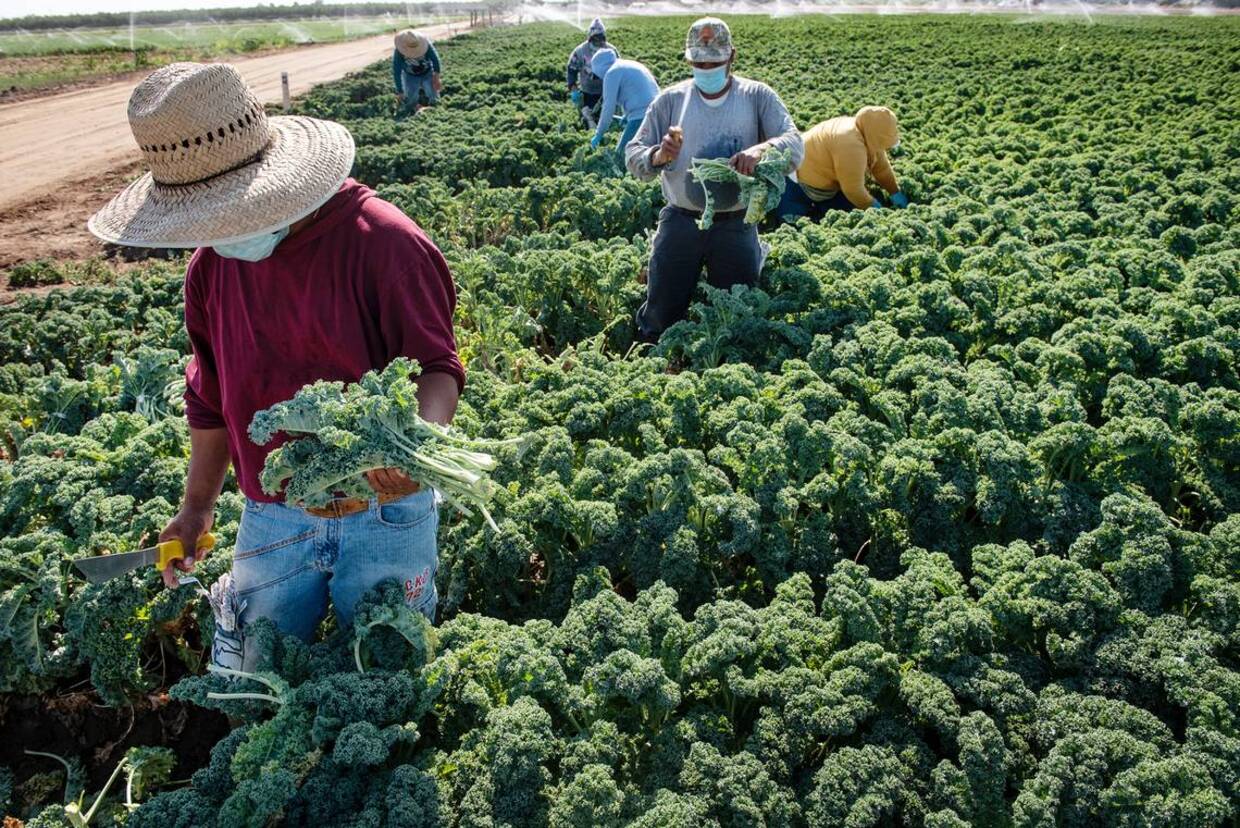Home>Gardening News and Trends>Latest News>What Happens When You Eat Pesticides


Latest News
What Happens When You Eat Pesticides
Modified: January 22, 2024
Discover the latest news on the potential risks of consuming pesticides and their effects on your health. Stay informed and make healthier choices.
(Many of the links in this article redirect to a specific reviewed product. Your purchase of these products through affiliate links helps to generate commission for Chicagolandgardening.com, at no extra cost. Learn more)
Table of Contents
Introduction
Welcome to a world where the food we consume is not always as natural and pristine as we might imagine. Pesticides, chemical substances used to eliminate pests and protect our crops, have become an integral part of modern agriculture. However, the use of pesticides raises concerns about their impact on human health and the environment.
As consumers, it’s important for us to understand what happens when we ingest pesticides and the potential risks associated with their consumption. This article aims to shed light on this issue, helping us make informed decisions about the food we eat.
Pesticides are designed to kill or repel various types of pests, including insects, weeds, fungi, and rodents. They may be applied to crops, fruits, vegetables, and even some processed food products to ensure their safety and commercial viability. The use of pesticides has significantly increased agricultural productivity, enabling farmers to protect their crops from damage and maximize yields.
However, the widespread use of pesticides has raised concerns about their potential adverse effects on human health. Studies have linked long-term exposure to pesticides with various health issues, including certain types of cancer, reproductive problems, neurodevelopmental disorders, and disruption of the endocrine system.
When we consume food contaminated with pesticides, such as fruits and vegetables treated with these chemicals, there is a risk of ingesting small amounts of the pesticide residues. These residues can remain on the surface or inside the produce, even after washing or cooking. While the levels of pesticide residues found in most food products are regulated and generally considered safe, the cumulative effects of long-term exposure are still a cause for concern.
It’s important to note that the potential risk associated with pesticide exposure depends on several factors, including the type of pesticide, dosage, duration of exposure, and individual susceptibility. Some pesticides are inherently more toxic than others, and certain demographic groups, such as children and pregnant women, may be more vulnerable to the effects of pesticide exposure.
In the following sections, we will delve deeper into the potential health risks of pesticide consumption, their impact on the digestive system, the environment, and the existing regulations and safety standards. Moreover, we will explore ways to minimize pesticide exposure and make more informed choices about the food we consume.
Understanding Pesticides
Pesticides are chemical substances specifically designed and utilized to eliminate or control pests that can harm crops, transmit diseases, or destroy property. They play a crucial role in protecting our agricultural produce and ensuring food security on a global scale. Pesticides come in various forms, including insecticides, herbicides, fungicides, and rodenticides, each targeting specific types of pests.
These chemicals work in different ways to combat pests. Insecticides are used to deter or kill insects that can damage crops, such as aphids, beetles, or caterpillars. Herbicides, on the other hand, are designed to control unwanted plants, commonly referred to as weeds, that compete with cultivated crops for water, nutrients, and sunlight. Fungicides target fungi that cause diseases in plants, while rodenticides are used to manage rodent populations that can cause damage to crops or spread diseases.
It’s worth noting that the use of pesticides is not limited to agriculture alone. These chemicals are also utilized in public health initiatives to control disease-transmitting insects, such as mosquitoes that carry malaria or dengue fever. Pesticides are also employed in industries such as forestry, landscaping, and building maintenance to protect against pests that can damage structures and harm human health.
While pesticides have undoubtedly contributed to increased crop yields and improved food production, their use raises concerns regarding their impact on human health and the environment. Some pesticides are classified as persistent organic pollutants (POPs), meaning they can remain in the environment and accumulate in living organisms over time. This can lead to long-term ecological consequences and potentially harm other species.
Furthermore, the use of pesticides can also result in the development of pesticide resistance in pests. Similar to how certain bacteria become resistant to antibiotics, pests can evolve to withstand the effects of pesticides, making them less effective over time. This necessitates the development and adoption of new pest management strategies to ensure crop protection.
While pesticides have undoubtedly been beneficial in protecting crops and managing pests, it’s crucial to strike a balance between the benefits and potential risks associated with their use. In the following sections, we will delve deeper into the potential health risks of pesticide consumption, their impact on the digestive system and the environment, as well as the existing regulations and safety standards surrounding their use. Additionally, we will explore ways to minimize pesticide exposure and make more informed choices when it comes to the food we consume.
Potential Health Risks
Consuming food contaminated with pesticide residues can pose potential health risks for humans. While the levels of pesticide residues found in most food products are regulated and generally considered safe, long-term exposure to these chemicals has been associated with various health concerns.
One of the primary health risks associated with pesticide exposure is the potential development of certain types of cancer. Several studies have found associations between pesticide exposure and an increased risk of cancers such as leukemia, lymphoma, lung, breast, prostate, and brain cancer. The exact mechanisms by which pesticides contribute to cancer development are still being studied, but it is believed that certain pesticides have carcinogenic properties or disrupt the body’s natural defense mechanisms against cancer cells.
Additionally, pesticide exposure has been linked to reproductive problems in both men and women. Studies have shown that certain pesticides can disrupt hormone balance, affecting fertility, reproductive function, and fetal development. Pesticides such as atrazine and glyphosate have been associated with decreased sperm count and quality in men, while exposure to organophosphates and pyrethroids during pregnancy has been linked to an increased risk of developmental disorders in children.
Neurodevelopmental disorders, such as autism spectrum disorder and attention deficit hyperactivity disorder (ADHD), have also been linked to pesticide exposure. Children exposed to pesticides in utero or during early childhood may experience neurological effects, including impaired cognitive function, learning difficulties, and behavioral problems. Studies have identified associations between pesticide exposure and an increased risk of neurodevelopmental disorders, emphasizing the need for precautionary measures to protect children from these potentially harmful chemicals.
Pesticide exposure can also disrupt the endocrine system, which regulates hormones in the body. Certain pesticides, known as endocrine-disrupting chemicals (EDCs), can mimic or interfere with hormones, leading to hormonal imbalances. This disruption has been associated with various health effects, including reproductive disorders, developmental abnormalities, and metabolic disorders such as obesity and diabetes.
While the health risks associated with pesticide exposure are concerning, it’s important to note that not all pesticides pose the same level of risk. Different pesticides have different levels of toxicity, and the potential health effects can vary based on the type of pesticide, dosage, duration of exposure, and individual susceptibility. Certain demographic groups, such as children and pregnant women, may be more vulnerable to the effects of pesticide exposure due to their developing bodies or the potential transfer of pesticides to the fetus.
In the next sections, we will explore the specific impact of pesticide consumption on the human digestive system, the environment, and the existing regulations and safety standards surrounding pesticide use. Additionally, we will discuss ways to minimize pesticide exposure and make more informed choices about the food we eat.
Impact on Human Digestive System
When we consume food contaminated with pesticide residues, these chemicals can have an impact on our digestive system. Although the levels of pesticide residues found in most food products are regulated and considered safe for consumption, long-term exposure to even low levels of pesticides can still have potential health implications.
Some pesticides are known to be toxic to the gastrointestinal tract and can cause irritation or inflammation. This can lead to symptoms such as abdominal pain, nausea, vomiting, and diarrhea. In more severe cases, prolonged exposure to certain pesticides can damage the lining of the gastrointestinal tract, leading to ulceration or even the development of gastrointestinal disorders.
Furthermore, the disruption of the gut microbiome is another concern associated with pesticide exposure. The gut microbiome consists of trillions of beneficial bacteria that play a crucial role in digestion, metabolism, and immune function. Studies have shown that certain pesticides, particularly those with antimicrobial properties, can alter the composition and diversity of the gut microbiota. This imbalance in the gut microbiome has been associated with various health issues, including gastrointestinal disorders, metabolic disorders, and even mental health disorders.
Additionally, pesticide exposure has been linked to an increased risk of food allergies and intolerances. Some pesticides can act as allergens or trigger allergic reactions in susceptible individuals. Furthermore, the chemical residues on food may interact with the body’s immune system, leading to the development of sensitivities or allergies to certain foods.
It’s important to note that the impact of pesticide exposure on the human digestive system can vary depending on factors such as the type of pesticide, dosage, frequency of exposure, and individual susceptibility. Not everyone will experience the same effects, and some individuals may be more sensitive to the effects of pesticide residues.
To minimize the potential impact on the digestive system, it is advisable to wash fruits and vegetables thoroughly before consuming them. Peeling fruits and vegetables can also reduce the exposure to pesticide residues, as some pesticides may be present on the surface. Additionally, opting for organic produce whenever possible can lower the risk of pesticide exposure, as organic farming practices generally prohibit the use of synthetic pesticides.
In the next sections, we will explore the impact of pesticide use on the environment, the existing regulations and safety standards surrounding pesticide use, and ways to minimize pesticide exposure for a healthier and more sustainable approach to food consumption.
Impact on the Environment
The use of pesticides has a significant impact on the environment, affecting not only the target pests but also other organisms and ecosystems. While pesticides play a crucial role in safeguarding agricultural production, their widespread use raises concerns about their potential negative effects on biodiversity, water quality, and ecosystem stability.
One of the major environmental concerns associated with pesticide use is the adverse impact on non-target organisms. Pesticides are designed to target specific pests, but they can also harm beneficial insects, birds, and other wildlife that play important roles in pollination, pest control, and maintaining ecological balance. Loss of biodiversity and disruption of ecosystem functioning can have wide-ranging consequences and impair the overall health and resilience of ecosystems.
Pesticides can also contaminate soil and water, posing risks to aquatic organisms and affecting the quality of our water resources. Runoff from agricultural fields, especially those treated with pesticides, can carry these chemicals into nearby streams, rivers, and lakes. This can lead to harmful algal blooms, fish kills, and the disruption of aquatic ecosystems. Furthermore, pesticides can persist in the environment for extended periods, accumulating in soil and potentially contaminating groundwater, which serves as a vital source of drinking water for many communities.
In addition to direct contamination, pesticides can also contribute to the development of pesticide resistance in pests. Continuous and excessive use of certain pesticides can lead to the emergence of resistant populations of target pests. This necessitates the use of higher concentrations or different types of pesticides, which can further contribute to environmental contamination and potentially lead to a cycle of escalating pesticide use.
Another concern related to pesticide use is the potential for the development of secondary pests. When pesticides are applied to control a specific pest, it can inadvertently disrupt the natural balance between pests and their natural predators. This disruption can result in the population growth of secondary pests, which may require further pesticide applications to control. This creates a vicious cycle that is detrimental to ecosystem stability and can ultimately lead to a greater reliance on chemical interventions.
To mitigate the impact of pesticides on the environment, integrated pest management (IPM) practices have been promoted as a more sustainable alternative. IPM focuses on utilizing a combination of strategies, such as biological control, crop rotation, use of resistant varieties, and targeted pesticide application, to minimize pesticide use while maintaining effective pest control. By adopting such approaches, farmers can reduce their reliance on pesticides and promote a healthier and more balanced ecosystem.
In the following section, we will explore the existing regulations and safety standards surrounding pesticide use, and discuss ways to minimize pesticide exposure for both human health and environmental sustainability.
Government Regulations and Safety Standards
To safeguard public health and mitigate the potential risks associated with pesticide use, governments around the world have implemented regulations and safety standards to ensure the safe and responsible use of these chemicals. These regulations aim to protect consumers, workers, and the environment from the adverse effects of pesticides.
In most countries, government agencies are responsible for establishing and enforcing pesticide regulations. These agencies set maximum residue limits (MRLs) for pesticides in food, which represent the maximum concentration of pesticide residues considered safe for consumption. These MRLs are determined based on extensive scientific research and risk assessments.
Before a pesticide can be approved for use, it must undergo rigorous testing to assess its safety. This includes evaluating its toxicity, persistence in the environment, potential for bioaccumulation, and impact on non-target organisms. The registration process involves submitting scientific data and studies to the regulatory authorities, who then review and evaluate the information to determine if the pesticide meets safety requirements.
Once a pesticide is approved, it is subject to ongoing monitoring and surveillance to ensure compliance with safety standards. Authorities conduct regular inspections and sampling of agricultural produce to assess pesticide residue levels and take appropriate action if violations are found.
In addition to protecting consumers, regulations also focus on safeguarding workers who handle and apply pesticides. Guidelines and safety measures are established to minimize occupational exposure and prevent health risks. This includes providing training, requiring the use of personal protective equipment (PPE), and implementing safe practices for handling, storing, and disposing of pesticides.
Furthermore, regulatory agencies often collaborate with industry stakeholders, research institutions, and independent organizations to promote the development and adoption of alternative pest management practices. Integrated pest management (IPM) strategies, which aim to minimize pesticide use through a combination of biological control methods, cultural practices, and targeted pesticide application, are encouraged as a more sustainable approach.
While government regulations and safety standards play a crucial role in protecting human health and the environment, it’s important for consumers to remain vigilant and informed. Understanding the potential risks associated with pesticides and making informed choices about the food we consume can further enhance our efforts to minimize exposure.
In the next section, we will discuss practical measures that can be taken to reduce pesticide exposure and make more informed decisions when it comes to food consumption.
Minimizing Pesticide Exposure
While regulatory measures are in place to ensure the safety of pesticide use, individuals can also take steps to minimize their exposure to these chemicals and make more informed choices about the food they consume. By adopting certain practices, we can reduce pesticide exposure and promote a healthier and more sustainable approach to food consumption.
One simple and effective way to minimize pesticide exposure is to choose organic produce whenever possible. Organic farming practices prohibit the use of synthetic pesticides, relying instead on natural methods to control pests. By opting for organic fruits, vegetables, and other food products, we can reduce our exposure to pesticide residues and support sustainable farming practices.
Washing fruits and vegetables before consumption is another crucial step in reducing pesticide exposure. While washing may not eliminate all pesticide residues, it can help remove surface contaminants. Use a gentle scrub brush and water to clean produce thoroughly. Peeling fruits and vegetables can also minimize exposure to pesticide residues, but keep in mind that some nutrients may be lost in the process.
Diversifying your diet and consuming a variety of foods can also help minimize pesticide exposure. By incorporating a wide range of fruits, vegetables, grains, and other food products into your meals, you are less likely to be exposed to a high concentration of pesticide residues from a single source.
Another approach is to grow your own food. By cultivating a garden or even growing herbs and vegetables in pots, you have control over the use of pesticides, if any. You can choose organic gardening practices and reduce or eliminate the use of synthetic pesticides altogether.
Staying informed about which foods tend to have higher pesticide residues can also guide your decision-making. The Environmental Working Group (EWG) publishes an annual list called the “Dirty Dozen” and the “Clean Fifteen,” which highlights the produce with the highest and lowest levels of pesticide residues. This can help you prioritize purchasing organic versions of the fruits and vegetables on the “Dirty Dozen” list.
Supporting local farmers’ markets and choosing locally sourced produce can also be a beneficial strategy. Many small-scale farmers practice sustainable farming and may use fewer pesticides compared to large-scale industrial farming operations.
Additionally, it’s important to remember that pesticide exposure is not limited to food alone. Pesticides can also be present in household products, such as insecticides and herbicides. By seeking natural alternatives or minimizing the use of such products, we can further reduce our overall exposure to pesticides.
By implementing these practices and making conscious choices about the food we consume and the products we use, we can make a positive impact on our health and the environment while supporting a more sustainable agricultural system.
Conclusion
Pesticides play a vital role in protecting crops and ensuring food security. However, it’s important for us to be aware of the potential health risks associated with pesticide exposure and take steps to minimize our exposure to these chemicals.
The use of pesticides can have significant implications for human health, including an increased risk of certain types of cancer, reproductive problems, neurodevelopmental disorders, and disruption of the endocrine system. The impact of pesticide exposure on the human digestive system and the environment is also a cause for concern.
Governments around the world have implemented regulations and safety standards to ensure the safe and responsible use of pesticides. These regulations aim to protect consumers, workers, and the environment from the adverse effects of these chemicals. However, as individuals, we can also take steps to minimize pesticide exposure.
Choosing organic produce, washing fruits and vegetables, diversifying our diets, and growing our own food are practical ways to reduce pesticide exposure. Staying informed about which food items tend to have higher pesticide residues can help guide our purchasing decisions. Supporting local farmers’ markets and minimizing the use of household pesticides are also effective strategies to lower overall exposure.
By adopting these practices, we can make more informed choices about the food we consume and contribute to a healthier and more sustainable approach to agriculture. Additionally, it’s important to continue supporting research and development of alternative pest management strategies, such as integrated pest management (IPM), to reduce reliance on synthetic pesticides and promote a balanced ecosystem.
Minimizing pesticide exposure is not only beneficial for our own health, but also for the environment and future generations. With conscious efforts, we can move towards a more sustainable and responsible approach to food production, ensuring a healthier and safer world for all.








